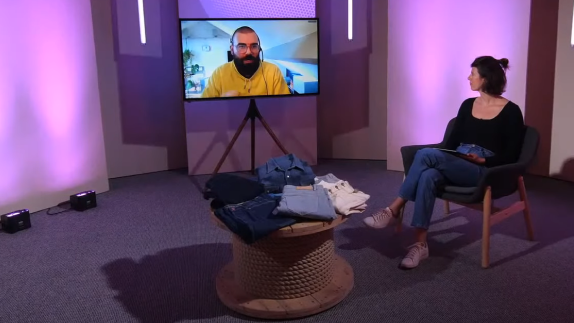
Tommy for Life is a pioneering circular business model that takes pre-owned Tommy Hilfiger and Tommy Jeans pieces as well as damaged items from retail operations to repair for resale, or remix into unique new styles.
What they do
Consumers are invited to trade in their pre-loved Tommy Hilfiger and Tommy Jeans items at Tommy Hilfiger and Tommy Jeans stores or send them via mail. In partnership with The Renewal Workshop, Tommy Hilfiger then sorts, cleans and repairs all items collected via customer take-back and damaged products from retail stores and ecommerce. Items that cannot be restored will be reinvented into unique styles as part of the Remixed collection. Those that cannot be remixed will be recycled into yarns, repurposed or donated via Tommy’s philanthropic arm, Tommy Cares.
Tommy for Life is tied to Tommy Hilfiger’s sustainability vision to create fashion that ‘wastes nothing and welcomes all’. With 24 targets towards 2030, Tommy Hilfiger’s approach to environmental and social sustainability focuses on circularity and inclusivity. Tommy Hilfiger’s vision is powered by PVH Corp.’s Forward Fashion strategy, a set of 15 priorities designed to reduce negative impacts to zero, increase positive impacts to 100% and improve over 1 million lives across its value chain.
Why is it an example of the circular economy?
Tommy Hilfiger is combining re-commerce and remanufacturing strategies to increase the number of users per item. Products are offered through two lines – Refreshed and Remixed – on the Tommy For Life website with items collected through customer take back and from damaged products from retail and ecommerce, which would otherwise be unsellable. By combining take back, resale and remaking, they are able to keep products in use for as long as possible, at their highest value, before eventually having control over the best options for end-of-use.
What are the benefits?
Customers are able to access quality, authentic Tommy Hilfiger products at a more accessible price point. Some users also enjoy the uniqueness of the items and the feeling of excitement when they find a rare item they love. Customers are also able to satisfy their desire to buy something new, with less environmental impact, increasing the ‘feel good’ factor of purchasing.
For Tommy Hilfiger, the programme offers a secondary revenue stream, which helps to build customer loyalty through the take back scheme and positive brand association with the reduced environmental impact of Tommy for Life. It also offers them a solution to recapture the value of damaged returns and items that have been damaged in store. The Renewal Workshop reports that typically brands receive 1-3% of their product back and are normally losing the value this stock holds by simply disposing of it.
How it works in detail
Tommy For Life started three years prior to its launch. It was set up to be able to work more independently from the larger business, and run more as a start-up in which, learning and adapting fast. To maximise learnings and speed of setup, Tommy For Life decided to partner with an external solution provider with the reverse logisticsreverse logisticsSupply chains dedicated to the reverse flow of products and materials for the purpose of maintenance, repair, reuse, refurbishment, remanufacture, recycling, or regenerating natural systems. knowledge and operations.
The Renewal Workshop handles the reverse logistics and single item handling of the Tommy for Life garments. Whilst the item handling can be expensive, it ensures that the products are high quality and all issues are identified and addressed before resale. It also creates a wealth of data on the most common points of damage on an item, which can be fed back into Tommy Hilfiger’s design process to create more durable products in the future.
Tommy For Life offers two product lines with two item condition levels – like new and very good. It mimics a traditional ecommerce platform whereby users can filter items by category and other variables. Currently, items are labelled as ‘refreshed’ and ‘remixed’ lines.
Refreshed: Renewed pre-owned or damaged pieces coming from stores and online operations
Remixed: Items which have been created or modified using material from items which could not be renewed. This line is set up to be a continuous drop of ‘one-of-a-kind’ items, made locally.


Next steps
Currently, Tommy for Life is hosted on a separate website to the main Tommy product offering. Moving forward, Tommy is looking to continue to integrate their circular operations into their core business, allowing customers to use store credit across all retail operations (e.g in store, online and within Tommy for Life). They are also developing their internal systems to streamline the product data collection, ensuring that product data is collected and stored in a constructive way which enables resale at a later date.
The experience and dedicated in-house teams that Tommy Hilfiger has built will enable them to effectively implement their circular business models moving forward, but there are industry-wide challenges such as the single-item handling process to re-commerce items which will need collaborative action to address. There is a need for standardisation across different retailers to align on best practices, enabled by technology.
Tommy Hilfiger is developing several circular business models and adapting their operations accordingly. For instance, they are looking at a range of options including small-scale rental pilots, in store repairrepairOperation by which a faulty or broken product or component is returned back to a usable state to fulfil its intended use. and customisation, digital fashion with The Fabricant and 3D-Stitch, and even virtual stores. They have plans to continue to scale Tommy for Life across Europe, expanding the availability of the Refreshed and Remixed garments.
Published 23 November 2021






